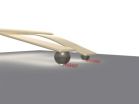(Press-News.org) The International Osteoporosis Foundation (IOF) has published practical guidelines to assist clinicians in assessing treatment efficacy in patients who experience a fracture while on medication for osteoporosis.
Osteoporosis drug therapy typically reduces the risk of fracture in the range of 30-70% for vertebral fractures, 40-50% for hip fractures and 15-20% for non-vertebral fractures. Nevertheless, even an effective therapy does not completely eliminate the risk of fracture, and some patients will experience a fracture while complying with their prescribed treatment.
This situation is not just worrying for the patient, it also poses a challenge for the physician who must decide whether to continue or discontinue with the treatment regimen. Does the fracture signify that the patient has failed to respond to the particular treatment? Should the type of treatment be changed? Or is the patient one of a significant minority who fails to respond to available treatments, for a number of many possible reasons?
The IOF Inadequate Responders Working Group, comprised of international experts on IOF's Committee of Scientific Advisors, outlines many of the issues associated with clinical decisions in the treatment of osteoporosis. Professor Adolfo Diez-Perez, chair of the Working Group, explains, "Treatment issues are extremely complex. In addition there is a scarcity of data about the effectiveness of alternative treatments when one has been deemed to have failed. Notwithstanding these complexities and limitations, the Working Group has used the best available evidence to create a check list of pragmatic criteria which can help doctors define treatment failure and take appropriate action."
The position paper, published in the journal 'Osteoporosis International', outlines how the response to treatment in patients who have been complying with their treatment for at least six months can be assessed on the basis of the number of fractures, changes in bone mineral density and bone turnover markers.
Professor Cyrus Cooper, chair of the IOF Committee of Scientific Advisers, stated: "Recent advances in the management of osteoporosis have led to large numbers of patients being treated with a variety of drugs. An increasingly frequent clinical conundrum is the management of a patient who sustains a fracture while on treatment. Although patient and physician may view this as a sign of treatment failure, this is not always the case. The objective of the current practical guidance was to provide a clinical pathway whereby physicians can ascertain whether a patient has failed to respond adequately to an anti-osteoporosis treatment. As a result, doctors will be able to define treatment failure more effectively, and take appropriate action. The algorithm produced pays testimony to the expert input from a host of international scientific advisers, coming together to address this important clinical topic in a timely and efficient manner."
###
Reference:
Treatment failure in osteoporosis
A. Diez-Perez, J. D. Adachi, D. Agnusdei, J. P. Bilezikian, J. E. Compston, S. R. Cummings, R. Eastell, E. F. Eriksen, J. Gonzalez-Macias and U. A. Liberman, et al.
Osteoporosis International 2012, DOI: 10.1007/s00198-012-2093-8
The position paper is freely accessible until November 2012 at http://www.springerlink.com/content/a6684g1110222536/
About IOF
The International Osteoporosis Foundation (IOF) is the world's largest nongovernmental organization devoted to the prevention, diagnosis and treatment of osteoporosis and related musculoskeletal diseases. IOF members – including committees of scientific researchers, patient, medical and research societies, and industry representatives from around the globe – share a common vision of musculoskeletal health without fragility fractures. IOF now represents more than 200 societies in all regions of the world. http://www.iofbonehealth.org
Has osteoporosis treatment failed when a fracture occurs?
New IOF position paper provides practical advice to help doctors assess patient response to osteoporosis treatment
2012-08-31
ELSE PRESS RELEASES FROM THIS DATE:
Immune system protein could explain pancreatitis
2012-08-31
It is likely that the protein is also highly significant for other inflammatory diseases.
The research results have been published in the American journal Gastroenterology.
Excessive alcohol intake and gall stones are known risk factors for acute pancreatitis. However, as yet no explanation has been found for what actually happens in the body in cases of acute pancreatitis.
Current research shows that calcium-sensitive proteins found in the body, for example calcineurin, promote inflammation, but it is not known exactly how.
Henrik Thorlacius and Maria Gomez at the ...
Danish scientists solve old blood mystery
2012-08-31
Scientists at the research centre MEMBRANES at Aarhus University, Denmark, have completed an old puzzle, which since the 60s from many sides has been regarded as impossible to complete. The challenge was to solve the structure of the protecting protein complex that forms when haemoglobin is released from red cells and becomes toxic. This toxic release of haemoglobin occurs in many diseases affecting red cell stability, e.g. malaria.
Technically, the most important finding in this report in Nature is a high-resolution three-dimensional mapping of the so-called 'haptoglobin-haemoglobin ...
Glass shape influences how quickly we drink alcohol
2012-08-31
Dr Angela Attwood and colleagues from Bristol's School of Experimental Psychology recruited 160 social drinkers aged 18-40 with no history of alcoholism to attend two experimental sessions. At one session they were asked to drink either lager or a non-alcoholic soft drink from either a straight-sided glass or a curved 'beer flute'.
The participants were almost twice as slow when drinking alcohol from the straight-sided glass compared to the curved glass. There was no difference in drinking rates from the glasses when the drink was non-alcoholic.
The researchers suggest ...
Researchers develop new, less expensive nanolithography technique
2012-08-31
Researchers from North Carolina State University have developed a new nanolithography technique that is less expensive than other approaches and can be used to create technologies with biomedical applications.
"Among other things, this type of lithography can be used to manufacture chips for use in biological sensors that can identify target molecules, such as proteins or genetic material associated with specific medical conditions," says Dr. Albena Ivanisevic, co-author of a paper describing the research. Ivanisevic is an associate professor of materials science and ...
Fear and driving opportunity motivated changes in driving behavior after 9/11
2012-08-31
A catastrophic event – such as a terrorist attack, a natural disaster, or market collapse – often strikes twice. There is the damage caused by the event itself, as lives are lost or left in ruin. But there is also the second act, catalyzed by our response to the catastrophic event. This second act has the potential to cause just as much damage as the first.
In the year following the terrorist attacks of September 11, 2001, there were approximately 1,600 more traffic fatalities in the United States than expected. This figure suggests the possibility that fear may have ...
Research yields two 'firsts' regarding protein crucial to human cardiac function
2012-08-31
TALLAHASSEE, Fla. -- Florida State University researchers led by physics doctoral student Campion Loong have achieved significant benchmarks in a study of the human cardiac protein alpha-tropomyosin, which is an essential, molecular-level component that controls the heart's contraction on every beat.
Using an imaging method called atomic force microscopy, Loong achieved two "firsts": the first direct imaging of individual alpha-tropomyosin molecules, which are very small — roughly 40 nanometers long — and the first demonstrated examples of a measure of the human cardiac ...
BUSM researchers study use of MRI in osteoarthritis
2012-08-31
(Boston) – A study conducted by researchers at Boston University School of Medicine (BUSM) shows that magnetic resonance imaging (MRI) detected a high prevalence of abnormalities associated with knee osteoarthritis in middle-aged and elderly patients that had no evidence of knee osteoarthritis in X-ray images.
Ali Guermazi, MD, PhD, professor of radiology at BUSM and chief of Musculoskeletal Imaging at Boston Medical Center (BMC), led this study in collaboration with researchers from Lund University in Sweden, Brigham and Women's Hospital in Boston and Klinikum Augsburg ...
BUSM researchers find potential key to halt progression, reverse damage from emphysema
2012-08-31
(Boston) – A study led by researchers at Boston University School of Medicine (BUSM) has shown that a compound used in some skin creams may halt the progression of emphysema and reverse some of the damage caused by the disease. When the compound Gly-His-Lys (GHK) was applied to lung cells from patients with emphysema, normal gene activity in altered cells was restored and damaged aspects of cellular function were repaired.
The study, which is published in BioMed Central's open access journal Genome Medicine, also demonstrates the potential impact of using genomic technologies ...
Mobile apps for diabetes present usability issues for older adults
2012-08-31
Diabetes is prevalent among adults aged 65 and older and can lead to a number of other serious health issues. Maintaining control of blood glucose levels is one of the most important actions diabetics can take to control their illness. New technology is designed to make self-monitoring easier and more accessible than ever before, but often tech products fail to accommodate some older users. Human factors/ergonomics researchers Laura A. Whitlock and Anne Collins McLaughlin evaluated the usability issues that older adults may experience with one type of emerging technology, ...
Wayne State researchers say adolescent smoking prevention programs still critical
2012-08-31
DETROIT — While many might see the case for programs to prevent adolescent cigarette smoking as already made, a pair of Wayne State University researchers believes that due to increasingly challenging economic times, policymakers need to be reminded to continue allocating funding for such programs.
Xinguang Chen, M.D., Ph.D., professor of pediatrics in the School of Medicine, and Feng Lin, Ph.D., professor of electrical and computer engineering in the College of Engineering, have found a way to provide policymakers with some hard evidence.
Most adult smokers in the ...
LAST 30 PRESS RELEASES:
Rare image of Tatooine-like planet is closest to its twin stars yet
Music: Popular song lyrics have become more negative since 1973
Marine ecology: Killer whales tail dolphins to hunt salmon
ADHD prescriptions on the rise, study finds
How to build a genome
Sharp rise in ADHD stimulant prescriptions in Ontario, research finds
Trends and prevalence of the metabolic syndrome among US adults
Population-level trends in ADHD medication prescribing
Missing piece of myelin disturbs the brain’s rhythm
Insilico Medicine and Taigen achieves license agreement to develop and commercialize AI-driven PHD inhibitor for anemia of Chronic Kidney Disease (CKD)
Exploring dominant endophytic Pleosporales in grasses: New taxonomic insights in the suborder Massarineae
Comparative transcriptomic analysis of human maxillary and mandibular tooth germs reveals discrepancies in gene expression patterns
Scientists detect atmosphere on molten rocky exoplanet - study
Chip-scale magnetometer uses light for high-precision magnetic sensing
Illinois Tech biomedical engineering professor Philip R. Troyk elected as Fellow of the National Academy of Inventors
The National Academy of Inventors welcomes 2025 Class of Fellows
Multi-scale modelling framework predicts mechanical responses of Fe–Cr–Al alloys across composition and processing conditions
Preoperative radiation may improve antitumor immune response in most common form of breast cancer
Breast MRI may be safely omitted from diagnostic workup in certain patients with early-stage, HR-negative breast cancer
Sentinel lymph node biopsy may be safely omitted in some patients with early-stage breast cancer
Rats may seek cannabis to cope with stress
New FAU research strengthens evidence linking alcohol use to cancer
Gut health à la CAR T
Dr. Pengfei Liu receives 2026 O'Donnell Award in Medicine for pioneering advances in genetic diagnostics and rare disease treatment
Dr. Yunsun Nam receives 2026 O'Donnell Award in Biological Sciences for pioneering RNA research transforming gene regulation and cancer therapy
Dr. Bilal Akin wins 2026 O'Donnell Award in Engineering for transformative work in EV energy systems and industrial automation
Dr. Fan Zhang receives 2026 O'Donnell Award in Physical Sciences for groundbreaking discoveries in quantum matter and topological physics
Dr. Yue Hu receives 2026 O'Donnell Award for revolutionizing energy operations with real-time AI and reinforcement learning
Greater risk that the political right falls for conspiracy theories
JMC Publication: Insilico’s AI platforms enable discovery of potent, selective, oral DGKα inhibitor to overcome checkpoint resistance
[Press-News.org] Has osteoporosis treatment failed when a fracture occurs?New IOF position paper provides practical advice to help doctors assess patient response to osteoporosis treatment

